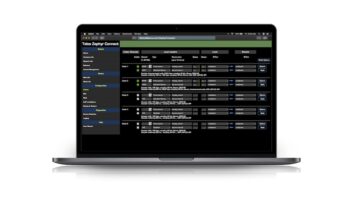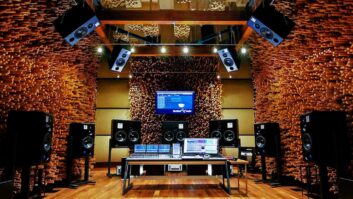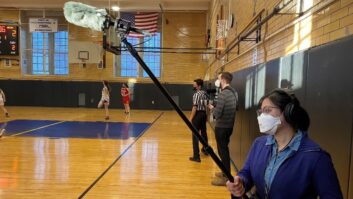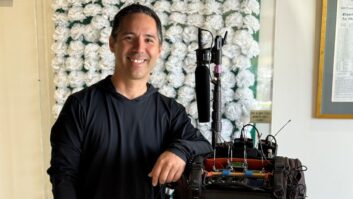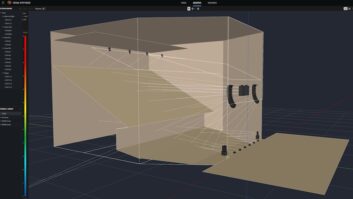B.B. King is not your average 75-year-old blues guitarist. Now entering his seventh decade as a recording artist, King marked the new millennium by opening his third B.B. King Blues Club, the latest addition to his already extensive portfolio of business enterprises. The newest club, the B.B. King Blues Bar and Grill (www.bbkingblues.com), is located on New York’s 42nd Street in the E-Walk complex between Broadway and Eighth Avenue and joins a chain that already includes similar establishments on Beale Street in Memphis, Tennessee, and in Universal City, California.
Featuring a 600-seat main room and an adjoining cafe, the B.B. King Blues Bar and Grill is outfitted with a sound system designed to cope with the wide range of blues, jazz and reggae artists booked to appear on an almost nightly basis. Designed by Amit Peleg and installed by his Peltrix company (Baldwin, NY), the sound system is based on speakers and amplifiers from the Dutch company, Stage Accompany (www.stageaccompany.com). For the main room, Peleg specified a total of 13 SA Champ Series C27 cabinets, supplemented by six Entertainer Series E24s, two SA Bass Series XL-bin and two SB 45 subwoofer cabinets. Monitors are SA Leader Series L27, L24 and L26 models. All speakers are powered by SA Efficiency Series ES 20 amplifiers.
As in many clubs, the stage is located in the center of the rectangular room, facing across the shorter dimension. Not only is the audience seating area all around the front and sides of the stage, calling for a 180-degree coverage pattern, but a significant part of the audience is seated at the two ends of the room, which brings up the need for a “long throw” configuration, or a delay system. Another complication common to clubs is a ceiling height of 15 feet, effectively reduced to 12 feet over the stage by beams above and the 30-inch stage height.
To achieve the required coverage, Peleg designed three clusters hung above the stage with SA Uni-Rig[TM] flying components. The center cluster comprises three Champ C27 cabinets arrayed in an arc, each C27 loaded with a single SA 1502 15-inch woofer and an SA 8535 Compact Ribbon Driver. Below these are hung two Entertainer E24s, each featuring the same ribbon HF driver and a single SA 1205 12-inch woofer. Side clusters consist of five C27s on top and two E24s below. Subwoofers are under the stage with the two XL-bins facing the front, each cabinet containing two SA 1513 woofers in a “tunnel-loaded” configuration. Two SB45 subwoofers, each containing three front-loaded SA 1513s, face down the longer sides of the room.
According to Peleg, who previously designed and ran the sound system at the Blue Note jazz club in New York, the SA clusters cover the entire room, eliminating the need for any delayed speakers. “In fact, the system has a much greater power capacity than will be ever be needed, but the rather large number of speakers was necessary for optimal coverage,” he notes. “The SA Ribbon Compact Driver puts out as much as a conventional compression driver but without the distortion. The system sounds great, and you can run it very loud all night, yet when you leave the club you have no ear fatigue – because there is no distortion.”
Apart from the subwoofers, which are fed an actively filtered signal via crossovers that plug into extension slots in the ES20 amps, all of the house speakers contain passive crossovers. The 13 SA ES20 power amps feature Dynamic Damping Control (DDC), which effectively reads the impedance at each speaker terminal in real time and feeds that back to the amplifier. DDC circuitry in the amplifier measures the return signal and compares it with the original signal at output stage of the amplifier, automatically compensating for any differences. The result is much tighter and more accurate mid and bass response and the elimination of “time smear,” thanks to improved cone excursion control.
To complete the installation, Peleg specified a Yamaha PM3500 for the house console and a Crest LM20 monitor console. System EQs are SA1310 (center cluster) and SA2310 (L and R clusters) models, and there are dbx 266XL stereo compressor and dbx 166XL compressor/gate models available for dynamics control. Microphone selection includes Shure SM57s and SM58s, Sennheiser MD-441, MD-431 and MD-409 models, an E-V RE20 and pairs of AKG 414 and AKG 460 condensers. Four Klark Teknik DN360 graphic EQs are on hand for monitor tweaking, and additional outboard gear includes Lexicon PCM 81 and Yamaha SPX990 reverbs.
“We also have a very extensive patch panel system,” notes Peleg. “There a lot of tie lines between monitor mixer and house console, and touring bands can patch their own control gear into the house system with ease. The company I contracted to do all the wiring, Manhattan Wiring, did a marvelous job.”
